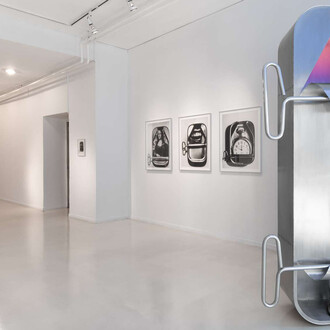Throughout his career, Oskar Kogoj has built his body of work with organic forms evolving from his exploration of the human body. Drawing from ergonomic and anthropometric studies he designed objects directly reminiscent of body parts, be it toys and baby care items or, much later, furniture from the Nature Design programme and softly-shaped decorative items that no longer exhibit a tangible desire to conform to the body, but instead bear symbolic messages from ancient ancestors.
Having completed his studies at the Venetian Istituto Statale d'Arte in 1966, Kogoj lectured at the same faculty and kept up with the Italian design that flourished in the artificial materials of the day, which were a challenge for the young designer at the time and, after his arrival in Nova Gorica, also an opportunity. When he joined the research institute of the Meblo factory in 1969, Kogoj began to develop a series of plastic lounge chairs together with a team of collaborators consisting of critic Stane Bernik, physician Janko Sušnik and mechanical engineer and Meblo secretary Boris Ferlat.
Judging from its appearance, the lounger made of polyurethane foam and upholstered with fur joined the museum collection already used, after the BIO 4 exhibition (4th Biennial of Industrial Design) in 1971, when the Gondola lounge chair family won the quality concept award. The exhibition catalogue indicates tendencies toward modularity and organic forms as well as an affinity for plastic materials. At the same exhibition, Kogoj was featured also with a series of screwdrivers with ergonomically designed handles that he created for the company TIK. To better capture the zeitgeist of the period we should look at one of the most groundbreaking pieces of the exhibition, Saša Mächtig’s kiosk K67, which combined all three of the above-mentioned qualities – modularity, organic forms and artificial materials. It should also be noted that BIO 4 was an exclusively Yugoslavian event, and that most of the items that aspired to compete with their international counterparts were featured again at BIO 5 two years later. While at BIO 4 Gondola was still only a “design concept”, it was already featured in the serial production category at BIO 5, in the company of similar outstanding pieces of Italian seating furniture. Some of the featured designers there were Giancarlo Piretti, Mario Bellini, Alberto Rosselli, and a group of authors of the acclaimed “Sacco beanbag” (Piero Gatti, Cesare Paolini, Carlo Santi, Franco Teodoro and Joe Colombo).
In order to avoid speculation as to who influenced whom and what came first it should be stressed that Kogoj conceived his lounge seat series for the domestic market, which was hungry for the Western aesthetic, at a time when foreign trends were steadily gaining momentum.
On this occasion, however, we are focusing our attention not on the extensive range of Kogoj’s pieces, but on the more technical, museum-specific issues of heritage preservation, namely on one of the loungers from the Gondola series. Ironically, museum exhibits composed of contemporary materials are more prone to aging than their older counterparts that were made of conventional materials. 20th-century materials are a considerable challenge for conservation and restoration professionals.
This essential activity runs parallel to our regular work in the museum in cooperation with professionals from other institutions – in this case with our colleagues from the Faculty of Natural Sciences and Engineering, the Institute for the Protection of Cultural Heritage of Slovenia and the Slovenian National Building and Civil Engineering Institute.
















